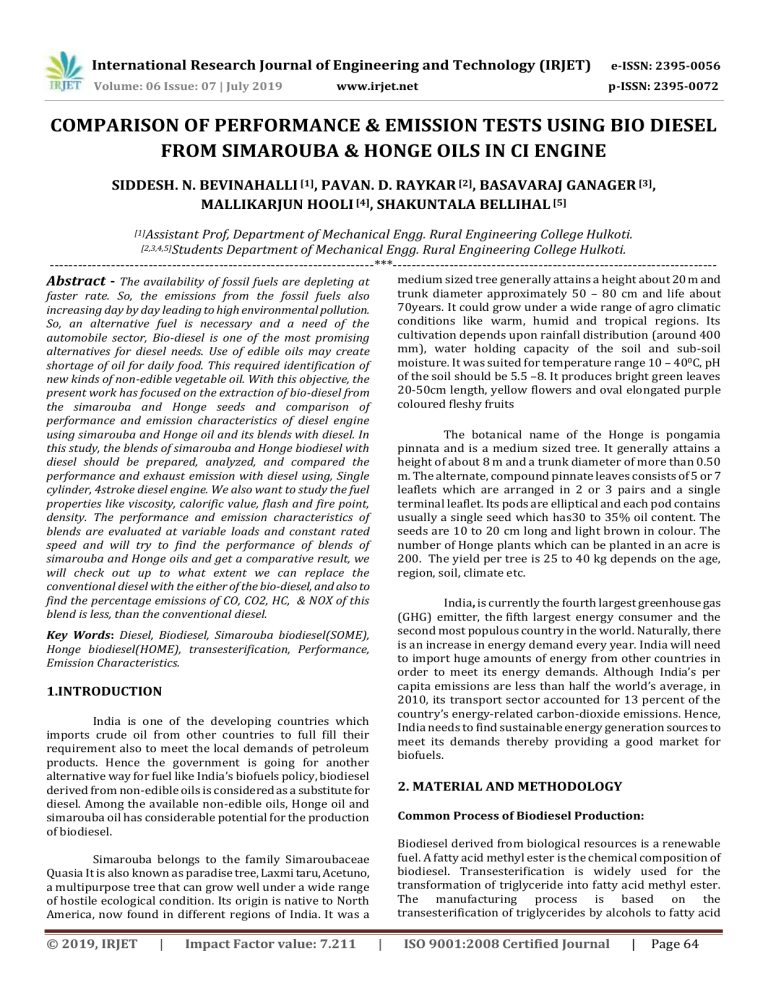IRJET-Comparison of Performance & Emission Tests using Bio Diesel from Simarouba & Honge Oils in CI Engine
advertisement

International Research Journal of Engineering and Technology (IRJET) e-ISSN: 2395-0056 Volume: 06 Issue: 07 | July 2019 p-ISSN: 2395-0072 www.irjet.net COMPARISON OF PERFORMANCE & EMISSION TESTS USING BIO DIESEL FROM SIMAROUBA & HONGE OILS IN CI ENGINE SIDDESH. N. BEVINAHALLI [1], PAVAN. D. RAYKAR [2], BASAVARAJ GANAGER [3], MALLIKARJUN HOOLI [4], SHAKUNTALA BELLIHAL [5] [1]Assistant Prof, Department of Mechanical Engg. Rural Engineering College Hulkoti. Department of Mechanical Engg. Rural Engineering College Hulkoti. ---------------------------------------------------------------------***--------------------------------------------------------------------[2,3,4,5]Students Abstract - The availability of fossil fuels are depleting at medium sized tree generally attains a height about 20 m and trunk diameter approximately 50 – 80 cm and life about 70years. It could grow under a wide range of agro climatic conditions like warm, humid and tropical regions. Its cultivation depends upon rainfall distribution (around 400 mm), water holding capacity of the soil and sub-soil moisture. It was suited for temperature range 10 – 400C, pH of the soil should be 5.5 –8. It produces bright green leaves 20-50cm length, yellow flowers and oval elongated purple coloured fleshy fruits faster rate. So, the emissions from the fossil fuels also increasing day by day leading to high environmental pollution. So, an alternative fuel is necessary and a need of the automobile sector, Bio-diesel is one of the most promising alternatives for diesel needs. Use of edible oils may create shortage of oil for daily food. This required identification of new kinds of non-edible vegetable oil. With this objective, the present work has focused on the extraction of bio-diesel from the simarouba and Honge seeds and comparison of performance and emission characteristics of diesel engine using simarouba and Honge oil and its blends with diesel. In this study, the blends of simarouba and Honge biodiesel with diesel should be prepared, analyzed, and compared the performance and exhaust emission with diesel using, Single cylinder, 4stroke diesel engine. We also want to study the fuel properties like viscosity, calorific value, flash and fire point, density. The performance and emission characteristics of blends are evaluated at variable loads and constant rated speed and will try to find the performance of blends of simarouba and Honge oils and get a comparative result, we will check out up to what extent we can replace the conventional diesel with the either of the bio-diesel, and also to find the percentage emissions of CO, CO2, HC, & NOX of this blend is less, than the conventional diesel. The botanical name of the Honge is pongamia pinnata and is a medium sized tree. It generally attains a height of about 8 m and a trunk diameter of more than 0.50 m. The alternate, compound pinnate leaves consists of 5 or 7 leaflets which are arranged in 2 or 3 pairs and a single terminal leaflet. Its pods are elliptical and each pod contains usually a single seed which has30 to 35% oil content. The seeds are 10 to 20 cm long and light brown in colour. The number of Honge plants which can be planted in an acre is 200. The yield per tree is 25 to 40 kg depends on the age, region, soil, climate etc. India, is currently the fourth largest greenhouse gas (GHG) emitter, the fifth largest energy consumer and the second most populous country in the world. Naturally, there is an increase in energy demand every year. India will need to import huge amounts of energy from other countries in order to meet its energy demands. Although India’s per capita emissions are less than half the world’s average, in 2010, its transport sector accounted for 13 percent of the country’s energy-related carbon-dioxide emissions. Hence, India needs to find sustainable energy generation sources to meet its demands thereby providing a good market for biofuels. Key Words: Diesel, Biodiesel, Simarouba biodiesel(SOME), Honge biodiesel(HOME), transesterification, Performance, Emission Characteristics. 1.INTRODUCTION India is one of the developing countries which imports crude oil from other countries to full fill their requirement also to meet the local demands of petroleum products. Hence the government is going for another alternative way for fuel like India’s biofuels policy, biodiesel derived from non-edible oils is considered as a substitute for diesel. Among the available non-edible oils, Honge oil and simarouba oil has considerable potential for the production of biodiesel. 2. MATERIAL AND METHODOLOGY Common Process of Biodiesel Production: Biodiesel derived from biological resources is a renewable fuel. A fatty acid methyl ester is the chemical composition of biodiesel. Transesterification is widely used for the transformation of triglyceride into fatty acid methyl ester. The manufacturing process is based on the transesterification of triglycerides by alcohols to fatty acid Simarouba belongs to the family Simaroubaceae Quasia It is also known as paradise tree, Laxmi taru, Acetuno, a multipurpose tree that can grow well under a wide range of hostile ecological condition. Its origin is native to North America, now found in different regions of India. It was a © 2019, IRJET | Impact Factor value: 7.211 | ISO 9001:2008 Certified Journal | Page 64 International Research Journal of Engineering and Technology (IRJET) e-ISSN: 2395-0056 Volume: 06 Issue: 07 | July 2019 p-ISSN: 2395-0072 www.irjet.net methyl esters, with glycerol as a byproduct. The base catalyzed production of biodiesel generally has the following processes. Transesterification: This is most commonly used process in production of biodiesel. It is most commonly used and important method to reduce the viscosity of vegetable oils. In this process triglyceride reacts with three molecules of alcohol in the presence of a catalyst producing a mixture of fatty acids, alkyl ester and glycerol. The process of removal of all the glycerol and the fatty acids from the vegetable oil in the presence of a catalyst is called esterification. Fig 2. Engine setup Engine Specification Product Engine Dynamometer Load sensor Compression ratio Fig1. Transesterification Process Table 1 Simarouba and Honge biodiesel blends compare with diesel properties Diesel SOME B10 SOME B20 HOME B10 HOME B20 Flash point(0C) 57 61 60 70 72 Fire point(0C) 63 66 64 90 95 Density(Kg/ m3) 830 833.7 837.4 823.3 853.3 0.0421 0.0495 0.0765 0.0612 0.0900 0.0337 0.0406 0.0643 0.0514 0.0756 42500 42230 41960 43600 43200 Kinematic viscosity VCR Engine test setup 1 cylinder, 4 stroke, Diesel (Comp.) Make Kirloskar, Type 1 cyl, 4 stroke Diesel, water cooled, power 3.5kW at 1500rpm, stroke 110mm, bore 87.5mm. 661cc, CR17.5, Modified to VCR engine CR 12 to 18. with electric start arrangement, battery and charge Cr Type eddy current, water cooled, Load cell, type strain gauge, range 0‐50 Kg 18:1 3. RESULTS AND DISCUSIONS 3.1 PERFORMANCE CHARECTERSTICS 3.11 LOAD V/S BREAK THERMAL EFFICIENCY (stroke) Dynamic viscosity (Poise) CV(KJ/Kg) Fig 3. LOAD V/S BTE © 2019, IRJET | Impact Factor value: 7.211 | ISO 9001:2008 Certified Journal | Page 65 International Research Journal of Engineering and Technology (IRJET) e-ISSN: 2395-0056 Volume: 06 Issue: 07 | July 2019 p-ISSN: 2395-0072 www.irjet.net 3.2 EMISSION CHARECTERSTICS 3.12 LOAD V/S SFC 3.21 LOAD V/S HC Fig 4 LOAD V/S SFC Fig. 7 LOAD V/S HC 3.13 LOAD V/S VOL.EFF 3.22 LOAD V/S CO Fig 5. LOAD V/S VOL.EFF Fig. 8 LOAD V/S CO 3.14 LOAD V/S EGT 3.23 LOAD V/S NOX Fig 6. LOAD V/S EGT © 2019, IRJET | Impact Factor value: 7.211 Fig. 9 LOAD V/S NOX | ISO 9001:2008 Certified Journal | Page 66 International Research Journal of Engineering and Technology (IRJET) e-ISSN: 2395-0056 Volume: 06 Issue: 07 | July 2019 p-ISSN: 2395-0072 www.irjet.net 3.24 LOAD V/S CO2 2. The BSFC decreased with an increase in engine load. For biodiesel and its blends, the BSFC are higher than that of diesel fuel. The BSFC values for biodiesels, SOME B20 is 0.32 which is higher than diesel fuel. Fig. 10 LOAD V/S CO2 3.25 LOAD V/S O2 3. The NOx emission is almost more or equal to diesel fuel for all modes of test fuels. This is due to higher oxygen content of biodiesel, which would result in better combustion and maximum cylinder temperature. The maximum value of NOx emission is 3% of SOME at full load conditions, which is higher than diesel fuel. 4. On the whole, the methyl esters of Simarouba biodiesel and its blends can be used as an alternative fuel in diesel engines without any engine modifications. It gives lower HC, CO emission when compared with the diesel fuel. But the addition of higher percentage of biodiesel blend with diesel fuel which decreases brake thermal efficiency and increases specific fuel consumption. 5. It is found that CO2 emissions are more for Simarouba biodiesel than that of diesel. Higher CO2 emissions reduce harmful CO emissions. The percentage reduction in HC emissions for Simarouba and Honge biodiesel is about 60% as compared to that of Diesel. Due to higher NOx emissions with pure Simarouba biodiesel, suitable blends can become a striking balance between NOx emissions on one end and all other emissions along with performance on the other hand. REFERENCES [1] P. RAKESH et.al, “Extraction of Simarouba Biodiesel and Experimental Investigation of Its Suitability as Fuel for Ci Engine”, International Journal of Professional Engineering Studies Volume VI /Issue 1 /NOV 2015. [2] Shruthi H Heroor, et al “Production Bio-fuel from Pongamia and its Performance on CI engine”, International Journal of Environmental Engineering and Management, Volume 4, Nov 6 2013, pp. 585-592. ISSN: 2231-1319. [3] Natesan KAPILAN, et al “Production and evaluation of storage stability of honge Biodiesel”, Annals of faculty engineering hunedoara – International Journal of Engineering year 2011, ISSN: 1584-2673. [4] Mishra S.R, et al “Production of Bio-diesel (Methyl Ester) from Simarouba Glauca Oil”, Research Journal of Chemical Sciences Volume 2(5), May 2012, pp.66-71, ISSN 2231-606X. Fig. 11 LOAD V/S O2 [5] Amaramma, et al “Extraction of Simarouba Biodiesel and Experimental Investigation of its Suitability as Fuel for CI Engine”, International journal of innovative research & development, Volume 3, Issue 6, June 2014, ISSN 2278-0211. 4. CONCLUSIONS 1. Performance, combustion and emission characteristics of SOME B20 blend. The maximum brake thermal efficiency of SOME B20 and DIESEL are respectively 26.74%, and 27.59% © 2019, IRJET | Impact Factor value: 7.211 | ISO 9001:2008 Certified Journal | Page 67 International Research Journal of Engineering and Technology (IRJET) e-ISSN: 2395-0056 Volume: 06 Issue: 07 | July 2019 p-ISSN: 2395-0072 www.irjet.net [6] Murthy P.V.K, Murali Krishna M.V.S, Sitarama Raju A, Vara Prasad C.M. Srinivasulu N.V. Performance evaluation of low heat rejection diesel engine with pure diesel. International journal of applied engineering research, dindigul volume 1, No 3, 2010. [7] Sivanathan Sivalaxmi and Thangavel Baluswamy. Experimental investigation on a diesel engine fueled with neem oil and its methyl ester, thermal science, year 2011, Vol. 15, No. 4, Pp. 1193-1204. [8] Lovekush Prasad1, Dr. Alka Agrawal, Experimental investigation of performance of diesel engine working on diesel and neem oil blends, iosr journal of mechanical and civil engineering (IOSRJMCE) ISSN: 2278-1684 Volume 1, Issue 4 (July-August 2012), PP 48-51. © 2019, IRJET | Impact Factor value: 7.211 | ISO 9001:2008 Certified Journal | Page 68


